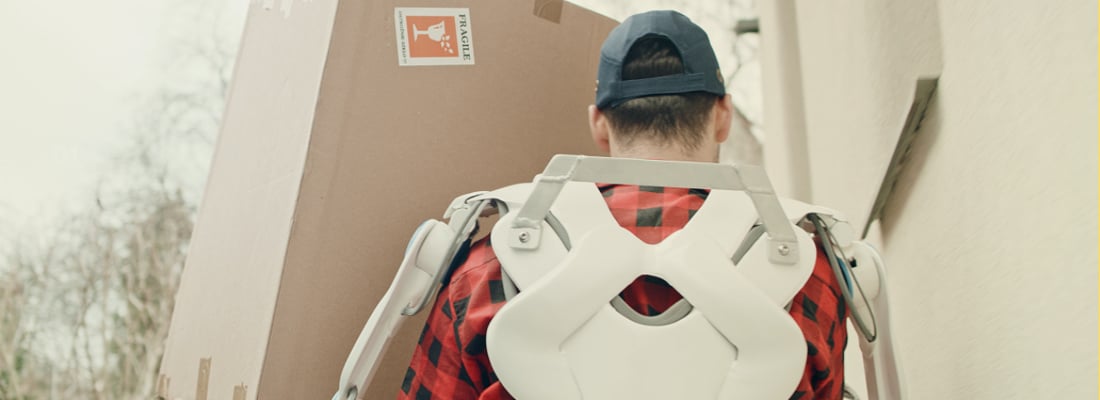Will exoskeletons make super humans of cleaning operatives?
Carrying out cleaning work is physically demanding and cost a lot of energy. Cleaning operatives are using various body parts intensively and are therefore at risk of various physical complaints. In this article, we will discuss the developments in the field of exoskeletons and how this contributes to minimizing the physical impact of daily cleaning.
What is an Exoskeleton?
The name exoskeleton (from Greek éxō "outer" and skeletós ‘’skeleton’’) originally comes from insects and marine animals that protect themselves with an external skeleton. The concept of an external frame is translated to a wearable and industrial skeleton made of hard materials, such as metals, plastics and fibres. The exoskeleton is worn outside the body and supports the user during tasks that can’t be automated.
Exoskeletons amplify human performance and are used to perform strenuous tasks, such as moving heavy loads, without significant effort and in a safe way. In this way, the user has to provide less muscle power and this is important, because less muscle strength means less stress on joints and tendons. Less muscle activity also means that a person will tire less quickly.
How does an exoskeleton work?
Exoskeletons are different from collaborative robots, because they’re fully controlled by the person wearing it, whereas robots operate independently. Collaborative robots will share the same workspace as humans, performing difficult, repetitive, thankless or dangerous tasks for them. The exoskeleton will support the cleaning operative with task that can’t be automated and both will coexist.
The current classifications for the exoskeletons are ‘’active’’ and ‘’passive’’. Active exoskeletons work with motors and have sensors. The sensors register what the motors need to "know" to deliver the right force at the right time. Passive exoskeletons do not have motors, but instead use a spring material. Once stretched, that material wants to return to the starting position. This leads to forces in the exoskeleton that provide the desired support, for example in a bent-over working posture. The latter is catching on more quickly because of lower costs and less complexity.
Passive exoskeletons are lighter and easier to use. However, they cannot adapt to the circumstances, such as the weight to be lifted. These exoskeletons are used on a modest scale. Active exoskeletons are more adaptive: the support can always adapt to the needs. As a result, they are potentially more widely applicable, but they are now even further removed from practice.
Should cleaning operatives use an exoskeleton?
In a previous article on ergonomic cleaning, we highlighted the importance of preventing common injuries by alleviating the heavy workload that operators face on a daily basis. An exoskeleton reduces the effort required of cleaning operators and can be used for a wide range of cleaning tasks, such as industrial cleaning, work to commercial high rise window cleaning and building maintenance.
About ten years ago, full-body exoskeletons received a lot of attention. These are large and heavy exoskeletons that deliver a lot of force over many joints, but cannot be used in practice. Over the past ten years, exoskeletons have been developed that cover a part of the body and provide support in a specific region. Thanks to innovative industries with large budgets, such as the automotive and aircraft industry there are now two types of mechanical industrial exoskeletons on the market: one that helps with lifting, reaching and repetitive movements outside of one's control. The second type helps with sitting and the last helps grabbing. Of these, the back and arm supporting exoskeletons are the most relevant, given the back and shoulder problems in physically demanding work.
In recent years, several pilots have been organized to allow cleaning employees of different ages, complaints, backgrounds and activities to use the exoskeleton. The results show that cleaning operatives using an exoskeleton are less tired after their shift, experience fewer physical complaints during work and are less stiff when they wake up the next day. People who went to the physiotherapist as standard, no longer had to do so.
So why don't all cleaning staff use an exoskeleton?
The possibilities of using an exoskeleton for cleaning operations are almost endless, but we do need to consider that the cleaning industry is a sector with many low-cost fighters who often deliver the same work, which makes it difficult to fundamentally implement a major change in sustainable employability. And knowing the costs of the exoskeleton can easily amount to between 5,000 and 10,000 euros; it becomes a long-term battle.
Exoskeletons help the cleaner to work safely and healthily. The results from pilots are promising, but it will take more time for the industry to adapt. Not just getting use to the technology, but more importantly; there is a lot to be achieved in cleaning by improving the work ergonomically. How should you lift and how should you clean? This is where the greatest gains can be made and the industry is aware of this. Cleaning operatives can be supported with aids such as exoskeletons, but this will not become the new standard for now.
Read more about what ergonomic cleaning is and how it reduces absenteeism
Share your stories with us!
Do you have an innovation or interesting news you would like to share with the professional cleaning and hygiene industry? The Interclean website and social media channels are a great platform to showcase your stories!
Please contact our press department interclean@rai.nl.
Are you an Interclean exhibitor?
Make sure you add your latest press releases to your Company Profile in the Exhibitor Portal for free exposure.
Receive the best newsletter on cleaning & hygiene - straight to your inbox!
We promise never to send you spam and you can unsubscribe at any time!







